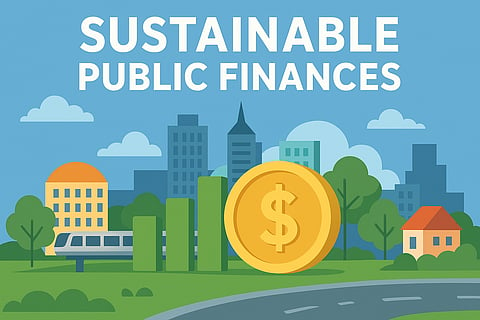Liveable Cities for the Next Generation Funded with Sustainable Non-tax Revenue
Rewilding Cities: Bringing Nature Back to Urban LifeBuilding sustainable cities isn’t only about protecting the climate and environment. Achieving sustainability also requires the financial capacity to invest in it. In other words, we need sustainable public finances.
Governments have two main sources of revenue: taxes and non-tax income. The latter comes from managing public assets and liabilities—the government’s balance sheet. And since neither taxes nor debt can rise indefinitely, cities must focus on what they already own. Put simply, public liabilities must never exceed the value of public assets. Sustainable public finances, just like personal or corporate finances, rely on maintaining a healthy net worth.
Resource-rich countries often generate non-tax income from oil, gas, or minerals. But even countries without natural endowments can tap into overlooked assets—if they manage them professionally.
Masdar City: Pioneering the Future of Sustainable Free Zones in the UAE
Singapore is a leading example. Despite having no natural resources, roughly one-fifth of its government spending is funded by non-tax revenues. Investment returns on public assets generate around 7% of GDP annually—nearly as much as the country collects from corporate taxes. This success is the product of decades of fiscal discipline and long-term strategy.
Today, Singapore has one of the world’s largest sovereign wealth portfolios, including Temasek Holdings, the Government of Singapore Investment Corporation (GIC), and the Monetary Authority of Singapore’s foreign reserves.
Together, these entities manage assets worth three to four times the country’s GDP—more than even the sovereign wealth funds of Norway or Saudi Arabia.
Globally, public assets are estimated to be worth about three times global GDP, with roughly half being commercial assets such as real estate and corporate holdings. Yet few governments systematically account for or manage these assets.
Countries like New Zealand—using accrual accounting to record all public assets and liabilities at market value—are the exception. Most governments continue to overlook vast swaths of their balance sheets, especially real estate, which alone is estimated to be worth as much as global GDP.
Infrastructure is often described as the engine of economic growth and productivity. Yet in many countries, roads crumble, railways stall, and basic services like water and electricity lag behind.
The usual explanation is a lack of funding—or a reluctance to raise taxes or cut spending. But governments already hold the key to unlocking investment, particularly in land and infrastructure.
Being the largest landowner in any jurisdiction gives governments a unique advantage, especially when developing entire neighbourhoods. Unlike private developers, governments are incentivised to maximise the value of the whole area, not just individual plots.
This often means allocating land to public goods—such as parks, schools, or transit—and coordinating land use to create more liveable communities.
Much of the overlooked public real estate lies around transport hubs—railways, ports, airports—or in disused industrial areas. Redeveloping these zones can significantly increase public wealth while driving urban renewal.
Hong Kong’s MTR Corporation offers a compelling model. Inspired by Japanese railways, MTR built a metro network comparable in size to New York’s—without relying on tax funding.
Instead, it used development rights around stations, with property revenue accounting for about 40% of its annual income since the 1990s. This “rail plus property” model turned infrastructure into a self-financing investment.
Cities like Hamburg and Copenhagen have achieved similar success by creating Urban Wealth Funds (UWFs) to manage and develop public assets.
In Hamburg, the city-owned HafenCity GmbH transformed a 2.4-square-kilometre harbour area into a vibrant district with 7,000 homes, commercial space for 35,000 workers, schools, universities, and cultural landmarks.
Copenhagen’s UWF, By og Havn I/S, redeveloped an old harbour and a former military site into an area twice the size of Hamburg’s project. The result: more than 33,000 new homes, 100,000 jobs, major infrastructure investments—including a metro extension—and new public spaces. All funded by revenues generated within the project itself.
These developments not only stimulate economic activity and create opportunities for the private sector; they also expand housing supply, enhance social mobility, and improve urban liveability—foundations of long-term prosperity.
When governments diversify their income sources beyond taxes, they reduce fiscal risk and strengthen economic resilience. At a time when public investment needs are soaring, taking a balance-sheet approach offers a powerful solution.
Focusing on net worth—the value of public assets minus liabilities—encourages better financial management than traditional debt-based rules, which often obscure the true fiscal position. Without a full understanding of their balance sheets, governments risk underinvesting, taking on poorly structured debt, and wasting resources.
Crucially, debt becomes a burden on future generations when it finances consumption or short-term political promises rather than productive assets. Intergenerational fairness requires that today’s borrowing create value for tomorrow’s citizens—not just today’s voters.
By setting net-worth targets, governments can shift incentives toward smarter, long-term investments in infrastructure, housing, and innovation—laying the groundwork for sustainable growth.
Ensuring sustainable prosperity means looking beyond short-term fixes and taking a strategic view of public assets and liabilities.
Effective balance-sheet management isn’t just better accounting—it’s one of the most powerful, yet underused, tools for unlocking economic potential.
By embracing a net-worth approach, governments can fund vital infrastructure, reduce reliance on taxes, and build cities that are both liveable and future-ready.
Read More: Rewilding Cities: Bringing Nature Back to Urban Life


